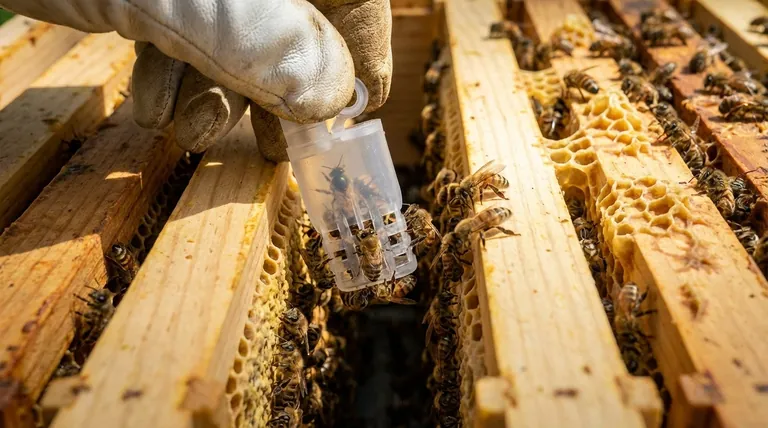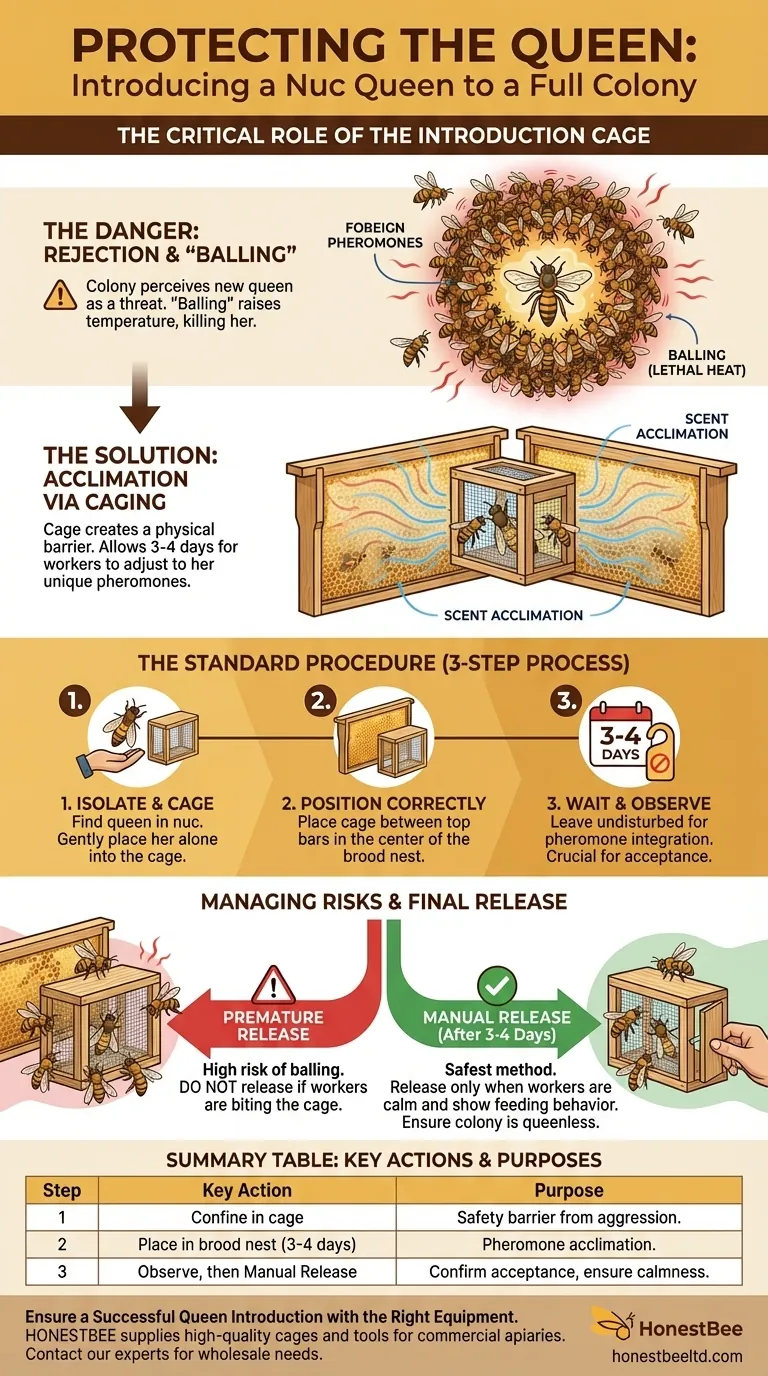To protect a queen from a nucleus colony (nuc) when introducing her to a full-size colony, you must first confine her within a queen introduction cage. This separation is the most critical step, as the full-size colony will initially perceive her as a foreign intruder and will likely attack and kill her. Caging the queen inside the new hive allows the worker bees to acclimate to her unique pheromones over several days, which is essential for a successful introduction.
The core challenge when merging a nuc is overcoming the hive's powerful instinct to reject a foreign queen. Caging the queen for 3-4 days inside the new colony is the standard, proven method to allow her scent to permeate the hive and convince the workers to accept her as their own.

Why Caging is a Critical First Step
A direct introduction of a new queen into an established colony will almost always fail. The caging process is designed to manipulate the colony's natural biology of acceptance, which revolves around scent and the absence of a prior queen.
The Decisive Role of Pheromones
Every queen produces a unique scent signature through her pheromones. This scent is what unifies the colony and allows worker bees to recognize their mother and hive mates.
A new queen brings an unfamiliar scent, which the colony's guard bees immediately register as a threat, triggering a defensive, aggressive response.
The Danger of "Balling"
When worker bees identify a foreign queen, they engage in a defensive behavior called balling. They will swarm the queen, forming a tight ball around her.
The bees in this ball vibrate their wing muscles, raising the temperature inside the ball to a lethal level, effectively "cooking" the queen to death. A queen cage provides a physical barrier that makes balling impossible.
The Acclimation Period
The cage's mesh screen allows house bees to get close to the new queen. They can touch her with their antennae, feed her, and, most importantly, become accustomed to her specific pheromones.
Over 3-4 days, her scent spreads throughout the hive. As the colony's old queen pheromones fade, the workers gradually begin to accept the new queen's scent as the dominant one.
The Standard Introduction Procedure
Follow these steps methodically. Rushing the process is the most common reason for failure.
Step 1: Find and Isolate the Queen
Before combining the nuc with the larger colony, you must find the queen on her frames.
Carefully pick her up by her wings or thorax and place her into a queen introduction cage. Do this gently and ensure she is alone in the cage, without any attendant bees from the nuc.
Step 2: Position the Cage Correctly
Place the queen cage inside the large colony's hive body, typically in the center of the brood nest.
The best placement is between the top bars of two frames. This ensures the cage is secure and that house bees have maximum access to the mesh screen to interact with her.
Step 3: Wait for 3 to 4 Days
This waiting period is non-negotiable. Close up the hive and leave it completely undisturbed.
This time allows for the crucial pheromone acclimation to occur. It also ensures the colony is definitively queenless and their desire to accept a new queen is at its peak.
Understanding the Risks and Trade-offs
While caging is highly effective, success depends on a correct assessment of the colony and proper execution.
The Risk of Premature Release
Releasing the queen before the 3-day minimum is extremely risky. If the bees are not yet acclimated to her scent, they may still ball and kill her the moment she is free.
Before opening the cage, observe the behavior of the workers on the mesh. If they appear calm and are attempting to feed her, it is a good sign. If they are biting at the cage or showing aggression, wait another day before checking again.
The "Manual Release" Method
The references point to a manual release, which is the most reliable method for this situation. After 3-4 days, you physically open the cage door and allow the queen to walk out onto the frame.
This method gives you final control and allows you to make a last-minute judgment based on the bees' behavior on the cage.
Confirming Queenlessness is Essential
This entire process is predicated on the receiving colony being queenless. If there is an undiscovered virgin queen, a failing queen, or laying workers present, the bees will never accept the new queen, and she will be killed upon release.
Making the Right Choice for Your Goal
Your approach should be dictated by a commitment to protecting the queen, who is the single most valuable asset in the colony.
- If your primary focus is maximum safety: Always use a queen cage and perform a manual release after 3-4 days, carefully observing the worker bees' behavior on the cage for any signs of aggression before opening it.
- If you are certain the colony is calm and has been queenless for some time: Caging is still the only recommended procedure. It eliminates guesswork and provides the highest probability of success.
- If you are dealing with an aggressive or agitated colony: Do not attempt an introduction until the colony has been queenless for several days and has calmed down. Caging remains essential.
Ultimately, a patient and methodical caging process is the single most effective strategy to protect your queen and ensure the long-term health of your colony.
Summary Table:
| Step | Key Action | Purpose |
|---|---|---|
| 1 | Confine the queen in an introduction cage. | Creates a safe physical barrier from aggressive workers. |
| 2 | Place the cage in the center of the brood nest for 3-4 days. | Allows worker bees to acclimate to the queen's pheromones. |
| 3 | Observe worker behavior before a manual release. | Ensures the colony is calm and ready to accept the new queen. |
Ensure a Successful Queen Introduction with the Right Equipment
Protecting your valuable queens is fundamental to maintaining strong, productive colonies. At HONESTBEE, we supply commercial apiaries and beekeeping equipment distributors with the high-quality, reliable queen introduction cages and other essential tools needed for this critical process.
Let us help you minimize losses and maximize hive health. Contact our wholesale experts today to discuss your equipment needs.
Visual Guide

Related Products
- Multi-Function Queen Roller Cage and Catcher
- Professional Multi-Functional Queen Bee Cage
- Durable Galvanized Steel Spring Queen Bee Cage
- Professional Multi-Compartment Queen Cage with Sliding Lid
- Wood and Mesh Push-In Queen Cage
People Also Ask
- What are the components of a standard queen cage? A Guide to Safe Queen Introduction
- When are queen cages typically used in beekeeping? Ensure a Successful Queen Introduction
- How do you check if the queen has been released after installation? A Guide to Successful Queen Acceptance
- What is the procedure for safely removing attendant bees from a queen cage? A Step-by-Step Guide for Beekeepers
- What are common problems during queen introduction? Ensure Hive Acceptance and Queen Survival


















